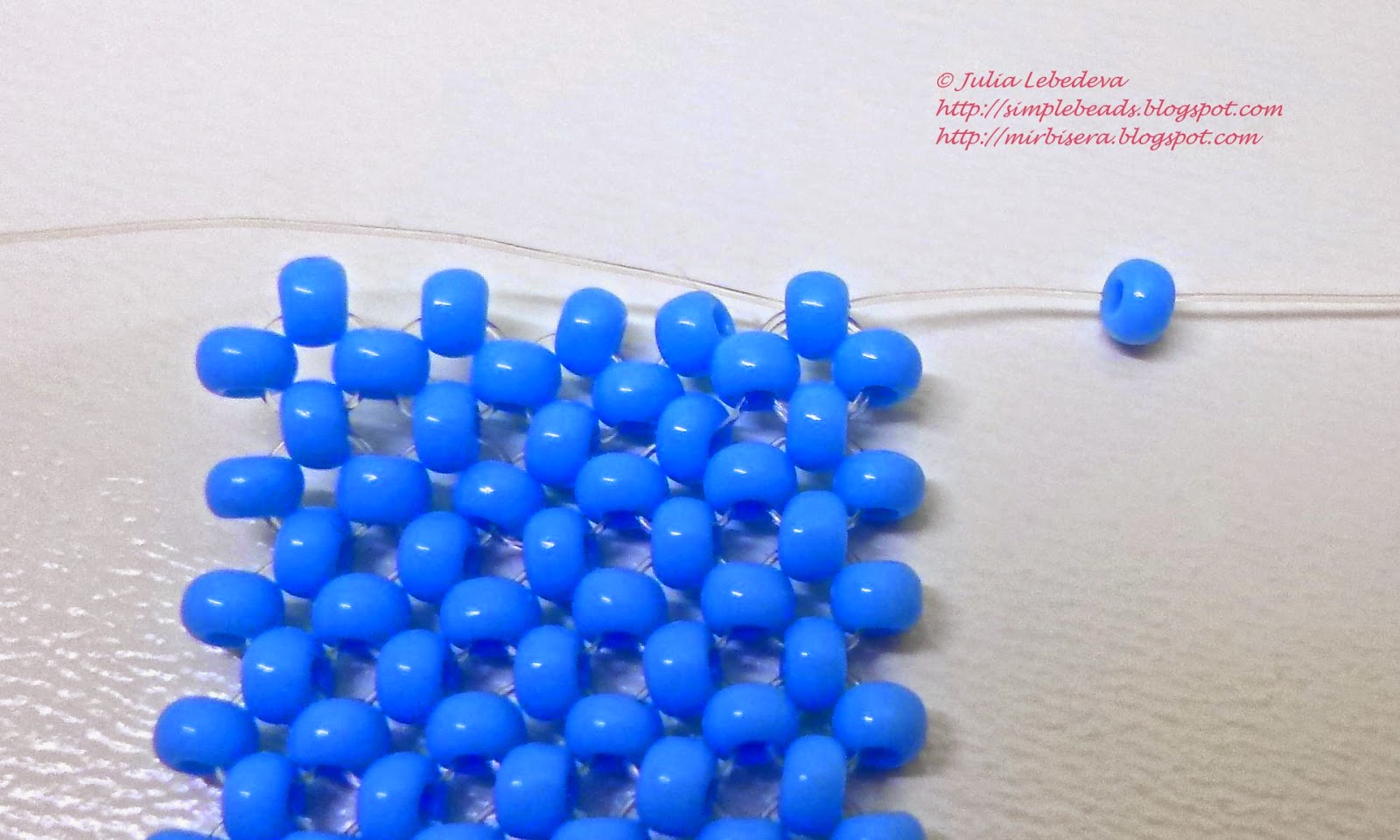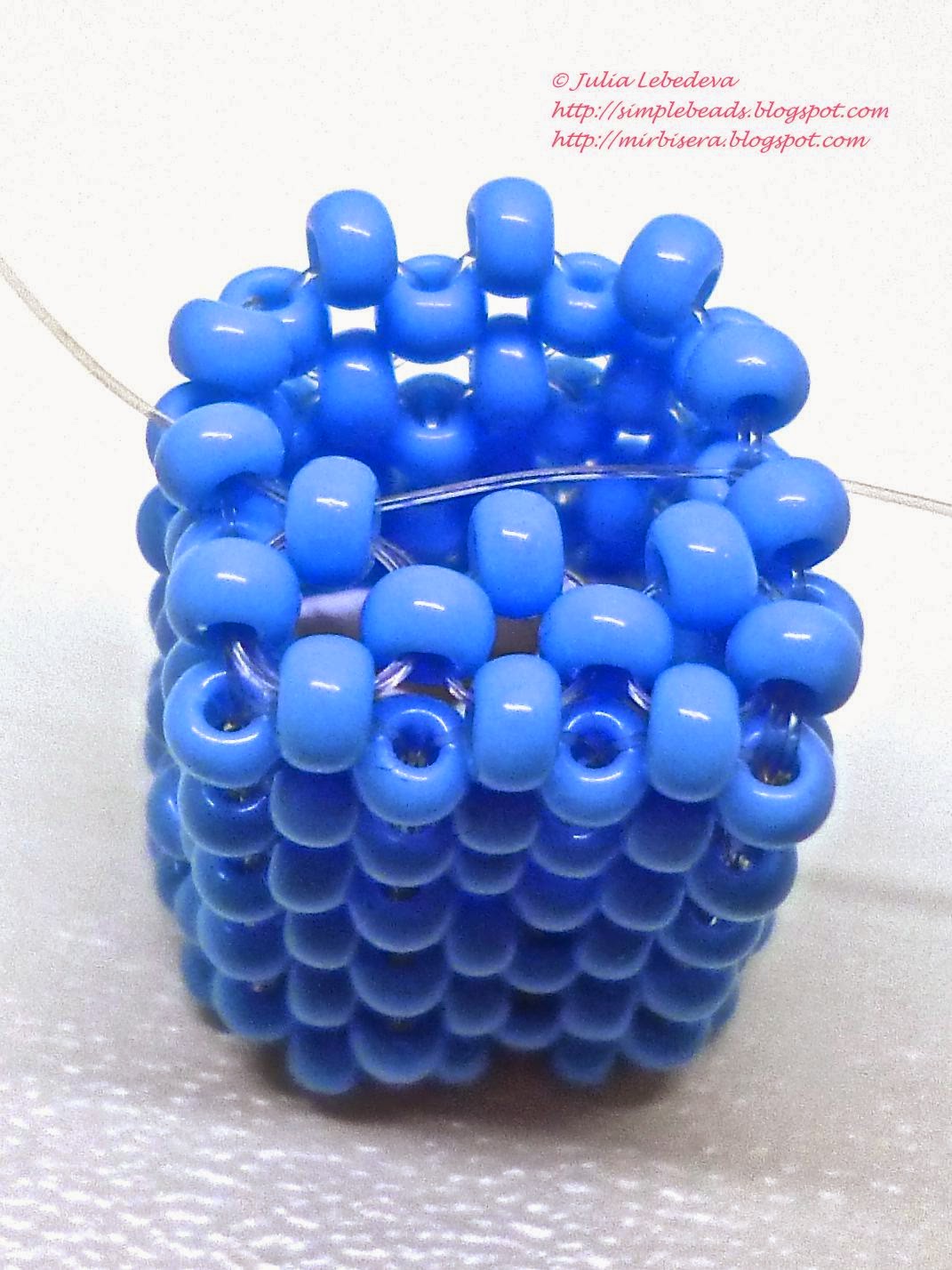Monday, February 9, 2015
Basics of Right Angle Weave. Part 2: weaving connecting elements in the flat right angle weave
We continue learning flat right-angle weave (RAW) stitch. In the previous tutorial we wove a beaded fabric and today we will learn how to make connecting elements using this fabric as the base.
We will need the same materials which were used in the previous tutorial:
- seed beads (I used size 8 seed beads);
- nylon fishing line and two beading needles (I used fishing line 0.3 mm in diameter).
In fact, all connecting elements in the flat RAW consist of a number of standard 4-bead units, which connect together the other 4-bead units, already existing.
There are two main types of such connecting elements, depending on where the existing 4-bead units are situated. The 1st type is a row that connects two other rows of 4-bead units. And the 2nd type is a beaded fabric that is to be woven in the space limited by the other 4-bead units.
Start weaving. Take the beaded fabric that we wove earlier,
and at first let’s connect the top and the bottom edges of this fabric, using additional beads. We should place these additional beads so that together with the protruding beads at the fabric’s edges they make up the new (connecting) row of 4-bead units.
String 1 bead onto the line that points outside,
then place both edges of the fabric close to each other and pass this line through the nearest protruding bead at the other edge.
Pull the line. Now we’ve got three of four beads necessary to build the 1st 4-bead unit in the connecting row.
To complete this unit, string 1 bead onto either line
and cross the other line through it.
Tighten the lines. The 1st 4-bead unit is completed.
After that pass the each line through the next protruding bead at an appropriate edge of the fabric,
then string 1 bead onto either line and cross the other line through it.
Tighten the lines. We’ve got the 2nd 4-bead unit.
In the same way make three more 4-bead units. The connecting row is finished.
Now let’s learn how to weave a beaded fabric in the space limited by the other 4-bead units.
Strictly speaking, as limitative elements we don’t need the 4-bead units themselves but only their single protruding beads, between which we will weave the new 4-bead units.
That is why now we will cover with beads one of the free sides of the item that we have just got.
At first, pass either line through the nearest protruding bead at the edge of the base, so that both lines should come out of the two adjacent beads at the base’s edge in opposite directions.
After that straighten the base so that its free side should be square and both lines should be in its bottom corner on the adjacent edges. Make sure that the each square’s edge has the size of three 4-bead units.
The beading technique that we will use for weaving the new side is very similar to the technique that we used for weaving the initial beaded fabric. We should note that the each 4-bead unit consists of 4 beads, so at the each step we should add the number of beads to have 4 beads in total to build the 4-bead unit.
We already have two of four beads necessary to build the 1st 4-bead unit. That is why we only need to add two beads this time. So, string 1 bead onto the lower line,
then string 1 bead onto the upper line
and cross this (upper) line through the bead at the other (lower) line.
Then pass it further through the nearest protruding bead at the edge of the base (that is the bottom bead of the next 4-bead unit).
Tighten the lines. We’ve got the 1st 4-bead unit of the 1st row of the new side.
In the same way make the next 4-bead unit in this row.
To make the last 4-bead unit in the row, pass the lower line through the nearest protruding bead at the adjacent edge of the base,
then string 1 bead onto this line, cross the other line through it
and pass it further through the next protruding bead at the adjacent edge of the base.
Tighten the lines. The 1st row of the new side is completed.
In the same way weave the 2nd row of the new side. We only need to change the direction of weaving.
We need to make the last row. This row connects the new side to the top edge of the base, so to make it we should use the technique similar to the technique that we used to connect the edges of the initial beaded fabric.
First, pass the upper line through the nearest protruding bead at the top edge of the base.
After that string 1 bead onto either line and cross the other line through it.
Tighten the lines. The 1st 4-bead unit of the last row of the new side is completed.
Then pass the each line through the next protruding bead at an appropriate edge,
after that string 1 bead onto either line and cross the other line through it.
Tighten the lines. We’ve got the 2nd 4-bead unit.
The last 4-bead unit in the row consists of the beads that we already have. So, to finish the side we should pass the each line through the next two beads that constitute the last 4-bead unit.
Tighten the lines. The new side is finished.
We have learned the basics of flat right-angle weave stitch. Now we can weave beaded fabric and some connecting elements. In the next tutorial we will make a beaded tiny purse using this technique.
P.S. If you like this tutorial, share it with your friends on social networks using the buttons below the post.
Don't want to miss new tutorials? Subscribe for email notifications of site updates or follow us on Twitter!
Subscribe to:
Post Comments (Atom)



































No comments:
Post a Comment